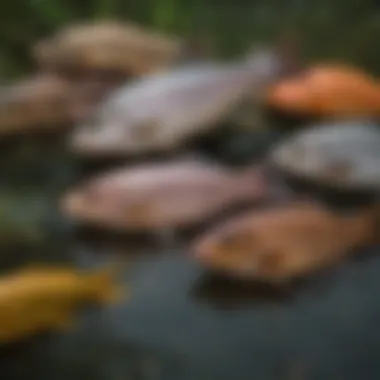Fishing Adventures Await at Lake Conroe Park


Intro
Lake Conroe Park is a destination that draws a diverse group of anglers each year. This location offers more than just an opportunity to fish; it serves as a gateway to understanding the local ecosystem. It showcases a variety of species that inhabit its waters and highlights ongoing conservation efforts.
In this article, we will explore the fishing opportunities available at Lake Conroe Park. We will examine the types of fish that can be caught, effective fishing techniques, the regulatory framework that governs fishing in the park, and the facilities provided. Our aim is to equip both novice and experienced anglers with the knowledge required to maximize their fishing experiences while promoting responsible fishing practices.
Animal Overview
Common Name and Scientific Classification
Lake Conroe Park is home to several fish species. Some prominent examples include the largemouth bass (Micropterus salmoides), striped bass (Morone saxatilis), and catfish, particularly the channel catfish (Ictalurus punctatus).
Physical Characteristics
- Largemouth Bass: Known for its elongated body and large mouth. The coloration typically shows a greenish hue with darker spots.
- Striped Bass: This fish is recognized by its silver body featuring horizontal black stripes running from head to tail.
- Channel Catfish: Distinguished by its whisker-like barbels near the mouth and a smooth body, ranging from a light gray to dark blue.
Habitat and Distribution
These fish species thrive in various parts of Lake Conroe. The largemouth bass prefers areas with structure, like fallen trees and submerged rocks. The striped bass often inhabits more open water regions, while channel catfish tend to favor the lake's deeper waters and areas with soft substrates. Understanding this distribution helps anglers choose the right fishing spots within the park.
Fishing Techniques
Employing effective fishing techniques increases the likelihood of a successful catch. For instance, using topwater lures can be particularly effective for catching largemouth bass during early morning or late evening hours. On the other hand, fishing with live bait, such as worms or shad, is known to attract catfish.
Regulatory Framework
Fishing at Lake Conroe Park is regulated to ensure sustainable practices and conservation. Anglers are required to adhere to licensing regulations, including obtaining a valid Texas fishing license. There are specific guidelines regarding catch limits and size restrictions for certain species, such as the striped bass.
Facilities at Lake Conroe Park
The park boasts several amenities that enhance the fishing experience. These include well-maintained fishing piers, picnic areas, and restrooms. The combination of these facilities provides a comfortable environment for families and avid anglers alike.
The park not only encourages fishing for recreation but plays a crucial role in local conservation efforts, providing habitat for diverse aquatic life and educating visitors on eco-friendly practices.
Ending
Lake Conroe Park presents a unique blend of recreational fishing opportunities combined with ecological awareness. By understanding the fish species present, the recommended techniques, and the necessary regulations, visitors can engage in responsible fishing while enjoying the beauty of the park. This approach benefits not just the anglers but also contributes positively to the local ecosystem.
Overview of Lake Conroe Park
Lake Conroe Park stands as an essential hub for fishing and outdoor recreation in Texas. It combines stunning natural landscapes with a wealth of aquatic biodiversity. Anglers visiting the park can expect a multi-faceted experience, from tranquil fishing spots to engaging local wildlife. This overview aims to highlight the various elements that make Lake Conroe Park a prime destination for fishing enthusiasts and those interested in understanding the local ecosystem.
Location and Accessibility
Lake Conroe Park is located in Montgomery County, near the vibrant town of Conroe. The park is easily accessible via Interstate 45 and is just a short drive from Houston. Its prime location makes it a convenient choice for both local residents and visitors.
The park features ample parking facilities, which are critical for those bringing boats and fishing equipment. The layout includes well-maintained pathways and designated fishing areas, making it ideal for anglers of all skill levels. Even families can visit with ease, given the clear signage and map available throughout the park.
Historical Significance
The history of Lake Conroe Park is intertwined with the development of Lake Conroe itself, which was constructed in the 1970s. Initially created for flood control and water supply, Lake Conroe has transformed into a significant recreational area.
Over the decades, the park has evolved, integrating various programs aimed at promoting conservation and education regarding aquatic ecosystems. Understanding the historical context of Lake Conroe enhances the fishing experience, as visitors gain insight into the area's environmental challenges and successes. This knowledge can inform responsible fishing practices and inspire a deeper appreciation for nature.
Fishing at Lake Conroe is not just about catching fish; it is also about embracing the natural beauty and history of the area.
Types of Fish in Lake Conroe


Understanding the types of fish found in Lake Conroe is critical for an enriching fishing experience. This aspect of fishing not only shapes the tactics and equipment that anglers use but also plays a significant role in local conservation efforts. Each species has its own habitat preferences, feeding habits, and seasonal behavior, influencing when and how one should fish.
Identifying the variety of fish species can enhance the overall outcome of one's fishing trip, making it more enjoyable and productive. This segment will offer insights into two primary categories of fish: popular game species and non-game species. Knowing what fish to target affects not only an angler's approach but also impacts the ecosystem of Lake Conroe.
Popular Game Fish Species
Popular game fish species in Lake Conroe draw many anglers to the park. These fish species are sought after not only for their catchability but also for the challenge they present, which adds excitement to the fishing experience.
- Largemouth Bass: This is one of the most sought-after game fish in the lake. The largemouth bass thrive in vegetation-rich areas, often hiding among weeds and submerged structures. They are known for their aggressive strikes, making them a favorite among anglers.
- Crappie: Often found in schools, crappies are known for their delicate flavor. They tend to congregate around submerged structures, making them accessible to anglers during the spring spawning period. Targeting crappie can provide a rewarding catch.
- Catfish: Both channel and blue catfish are abundant in Lake Conroe. They are particularly active during warmer months and are known for their size and strength, which presents both a challenge and thrill for anglers.
- Bluegill: This species offers a more straightforward fishing experience, often attracting families and beginners. They spawn in shallow waters, making them easy to find and catch, providing an excellent introduction to angling.
Engaging with these species requires distinct techniques, ensuring that anglers can choose the right methods to maximize their success.
Non-Game Fish Species
While game fish capture the attention of many anglers, non-game fish also play a vital role in the aquatic ecosystem of Lake Conroe. These species contribute to the biodiversity of the lake and can offer unique insights for fishing enthusiasts.
- Shad: Often considered bait fish, shad are crucial for the lake's food web. Knowledge of shad migration and schooling behavior can assist anglers in targeting predatory species during fishing outings.
- Carp: Though not typically a target for sport fishing, carp can provide an excellent fight and are abundant in Lake Conroe. They present a unique challenge for anglers looking for something different.
- Sunfish: This group includes several small species that contribute to the lake's ecology. They often serve as forage for larger game fish, making them integral to the fishing landscape.
Understanding the biology and behavior of both game and non-game fish species can significantly enhance an angler's experience. This knowledge not only aids in catching fish but also contributes to sustainable practices, supporting the ecosystem's health for future generations.
Best Fishing Techniques
Fishing is not merely an act; it is an art that requires understanding and skill. This section emphasizes the best fishing techniques for the unique environment of Lake Conroe Park. Understanding various techniques can greatly enhance the chances of a successful fishing trip. Anglers should consider the specific fish species, weather conditions, and personal preferences for gear and tackle.
Bait Fishing
Bait fishing remains one of the most straightforward yet effective methods for catching fish at Lake Conroe. This method involves using live or artificial bait to attract fish.
Key Points:
- Live Bait: Common choices include worms, minnows, or shrimp. These options tend to draw in a wider variety of fish species.
- Artificial Bait: Lures made from plastic, metal, or rubber can mimic the movement of prey, making them appealing to fish.
- Techniques: Cast the line and allow it to settle. Then, gently retrieve it to create movement that can entice fish.
Using bait can improve the likelihood of a catch. Different fish species are attracted to different types of bait. Therefore, research is essential before heading out.
Fly Fishing Techniques
Fly fishing is a specialized method that requires skill and finesse. It involves using a lightweight lure called a fly. This technique can be particularly effective in certain areas of Lake Conroe where the fish tend to feed near the surface.
Considerations:
- Equipment: A fly rod, reel, and specific types of flies are necessary. Selecting the right fly can determine success. Various types include dry flies, wet flies, and streamers.
- Casting Techniques: Mastering the cast is crucial. The goal is to land the fly gently on the water surface to mimic natural insects.
- Timing: Early mornings or late evenings are often the best times for fly fishing, as fish tend to be more active.
Successfully employing fly fishing can be rewarding. It not only requires skill but also a keen observation of the environment and fish behavior.
Tackle and Gear Recommendations
The right tackle and gear can significantly impact the fishing experience. Ensuring quality equipment tailored for the specific conditions at Lake Conroe is essential for anglers of all skill levels.
Recommendations:
- Rods and Reels: Choose a rod suited for the type of fishing method. A medium-action spinning rod is versatile for bait fishing, while a lighter rod is ideal for fly fishing.
- Line Types: Monofilament, fluorocarbon, and braided lines each have unique advantages. Monofilament is easier to manage, whereas braided lines offer strength and sensitivity.
- Hooks and Weights: Opt for various hook sizes depending on the targeted fish species. Using the right weight helps ensure the bait reaches the desired depth.
By selecting appropriate tackle and gear, anglers enhance their likelihood of success while ensuring a more enjoyable experience.
Consider your skill level and fishing style when choosing your tackle. Various fishing conditions may require adjustments in your gear.
Fishing Regulations at Lake Conroe


Fishing regulations play a crucial role in maintaining the ecological balance of Lake Conroe. They ensure sustainable fishing practices that protect fish populations and preserve the health of the lake's environment. Understanding these regulations is essential for anglers who want to make the most of their fishing experience while adhering to legal requirements. Compliance with these rules fosters a responsible fishing culture and contributes to the conservation of aquatic habitats.
Licensing Requirements
In order to fish legally at Lake Conroe, anglers must obtain a valid fishing license. This requirement applies to individuals aged 17 and older. The Texas Parks and Wildlife Department oversees the issuance of these licenses. You can choose from several options, such as a regular fishing license or a combination hunting and fishing license. Many are available for purchase online or at local retailers. Keeping your fishing license on hand is important, as you may be asked to show it during your fishing trip.
Seasonal Restrictions
Seasonal restrictions are designed to protect fish populations during their spawning periods and to ensure a balanced ecosystem throughout the year. At Lake Conroe, anglers should note specific times when certain species may be off-limits to fishing. For instance, many fish species, like largemouth bass, often have designated closed seasons. These rules help to maintain fish numbers and ensure that future generations can enjoy fishing in the lake. It is advisable to check local regulations for updates and specific dates before planning your fishing trip.
Understanding the fishing regulations is vital not only for compliance but also for the health of Lake Conroe’s ecosystem. Be aware of licensing and seasonal rules to enhance your fishing experience responsibly.
Facilities and Amenities at Lake Conroe Park
Facilities and amenities play a crucial role in enhancing the fishing experience at Lake Conroe Park. They cater not only to seasoned anglers but also to families and casual visitors. A well-equipped space ensures that everyone can enjoy their time on the water safely and conveniently. Understanding these facilities is essential to maximize the experience during a fishing trip.
Fishing Piers and Boat Launches
Lake Conroe Park features several fishing piers and boat launches that facilitate easy access to the water. The fishing piers are strategically placed at various points along the shoreline. They provide anglers with excellent vantage points for casting their lines. Some piers are specifically designed for accessibility, ensuring that people of all abilities can participate in fishing activities.
Boat launches are crucial for those wishing to use larger vessels for fishing. The designated launching areas are maintained to ensure a safe and smooth transition from land to water. Proper access to boat launches can make a significant difference. It reduces waiting times and enhances the overall fishing experience. The proximity of these launches to prime fishing spots is also a noteworthy advantage, as it allows quick transitions to productive areas.
Restrooms and Picnic Areas
Visitors to Lake Conroe Park benefit from well-maintained restroom facilities located throughout the park. These restrooms offer a necessary convenience for all, especially families spending the day fishing. Clean and accessible facilities contribute significantly to the overall comfort of park visitors.
The picnic areas around the park offer a perfect setting for families to relax and enjoy meals together. Located near scenic views, these spaces allow for rest between fishing sessions or even after a long day on the water. Having designated picnic spots encourages a day out that combines fishing with leisure, making it a well-rounded family experience.
In summary, the facilities and amenities at Lake Conroe Park foster an enriching environment for anglers and their families. With appropriate resources, safety measures, and convenience in place, visitors can focus on what truly matters—the joy of fishing.
Environmental Conservation Efforts
Environmental conservation efforts are crucial for preserving the delicate ecosystems found within Lake Conroe Park. As a popular fishing destination, it becomes increasingly important to ensure sustainability. These initiatives protect local wildlife and their habitats while also maintaining the water quality, which is essential for both fish and anglers alike. By engaging in conservation, the park can continue to support fishing activities and promote a healthy environment for future generations.
Conservation programs can lead to several benefits, including:
- Biodiversity Preservation: Protecting various species ensures a balanced ecosystem, which is vital for the overall health of Lake Conroe.
- Enhanced Fishing Opportunities: Healthy habitats support greater fish populations, resulting in improved fishing experiences for all.
- Visitor Education: Efforts to educate the public about local wildlife and ecosystems foster a sense of responsibility towards the environment.
- Community Involvement: Engaging local community members in conservation efforts strengthens ties and empowers them to contribute toward positive change.
The presence of sound environmental conservation policies at Lake Conroe Park not only enhances fishing activities but also reinforces the park's role as a sanctuary for various species.
Habitat Protection Initiatives
Habitat protection initiatives form the backbone of conservation efforts at Lake Conroe Park. Such initiatives aim to maintain, protect, and sometimes rehabilitate vital ecosystems that support local wildlife populations. Key components of these activities include:
- Wetland Restoration: Restoring wetlands improves water quality and provides essential breeding habitats for fish and other aquatic species.
- Buffer Zones: Establishing buffer zones around water bodies mitigates the impact of pollutants and human activities, ensuring cleaner water and healthier wildlife habitats.
- Wildlife Corridors: Creating corridors allows animals to move freely between habitats, promoting genetic diversity and resilience.
These initiatives contribute to a sustainable habitat where both fish populations and recreational activities can flourish. As such, visitors can enjoy all that Lake Conroe has to offer without compromising its ecological integrity.
Invasive Species Management
Invasive species pose a significant threat to the natural balance within Lake Conroe Park. They can outcompete native species for resources, disrupt food webs, and alter habitats. Effective invasive species management is essential to safeguard local biodiversity. Key strategies include:
- Regular Monitoring: Keeping a close eye on species populations helps in early detection of invasive species.
- Public Education: Educating visitors about the impact of invasive species encourages them to report sightings and prevent their spread.
- Eradication Efforts: Implementing targeted removal strategies can help minimize the presence of harmful non-native species.
- Restoration Projects: Following successful eradication efforts, restoration projects can reintroduce native plants that support local ecosystems.
These management efforts not only contribute to the health of Lake Conroe Park's ecosystems but also help ensure that fishing opportunities remain abundant and sustainable for all who visit.
Community Programs and Events


Community programs and events at Lake Conroe Park play a crucial role in enhancing the overall fishing experience for both seasoned anglers and families. These initiatives foster a sense of community, promote environmental education, and encourage responsible fishing practices. By participating in these programs, individuals can deepen their appreciation for the local ecosystem while forging connections with like-minded people.
Fishing Tournaments
Fishing tournaments at Lake Conroe are organized periodically, attracting anglers of all skill levels. These events create a competitive environment which not only challenges participants but also enhances their fishing skills. Tournaments can be fun and rewarding, often accompanied by prizes for the largest catches or most fish caught.
For participants, tournaments offer an opportunity to network with other fishing enthusiasts, learn from each other, and share techniques. It's also an occasion to support conservation efforts through a portion of the entry fees often being donated to local wildlife protection organizations.
In addition, these tournaments can serve as a platform for educating new anglers about fishing regulations and sustainable practices. It encourages participants to adhere to legal limits and fosters a sense of stewardship for the aquatic environment.
Environmental Workshops
Environmental workshops are another important aspect of community programs at Lake Conroe Park. These workshops aim to raise awareness about local ecosystems, conservation efforts, and the impact of human activity on aquatic life. Participants have the chance to engage in discussions centered around habitat preservation, aquatic biodiversity, and responsible fishing practices.
Workshops often cover topics such as:
- Invasive species: Their impact on local fish populations and ecosystems.
- Water quality: Understanding how pollution affects fish habitats.
- Sustainable fishing: Practices that minimize environmental impact.
Not only do these workshops inform participants, but they also inspire action. Individuals leave with knowledge that empowers them to protect and respect the natural resources within Lake Conroe. The combination of education and community involvement ultimately contributes to a healthier lake and a more vibrant fishing community.
Engaging with local community programs enhances both the fishing experience and environmental conservation efforts.
Safety Guidelines for Anglers
Fishing at Lake Conroe Park can be an enjoyable and rewarding experience. However, safety should always be a priority for every angler. Understanding and adhering to safety guidelines not only protects individuals but also fosters a responsible fishing culture. Following these guidelines can prevent accidents, ensure compliance with regulations, and enhance the overall enjoyment of the fishing experience.
Water Safety Tips
When engaging in fishing activities, especially those involving watercraft or wading, water safety becomes critical. Here are some essential tips:
- Wear a Life Jacket: It is crucial to wear a properly fitted life jacket, particularly for those boating. This simple measure can save lives.
- Check Weather Conditions: Always review current weather forecasts before heading out. Sudden changes in weather can pose significant risks.
- Stay Aware of Surroundings: Keep an eye out for other boats, swimmers, and obstacles in the water. Awareness can prevent collisions and accidents.
- Know the Depth: Before venturing into unfamiliar areas, understand the water's depth to prevent slips or unexpected watery incidents.
- Avoid Alcohol: Consuming alcohol while fishing can impair your judgment and reaction times, leading to dangerous situations.
Safety begins with being prepared and aware. Let’s prioritize our well-being while enjoying nature.
Personal Safety Considerations
Aside from water safety, personal safety is equally important to ensure a successful fishing outing. Here are some personal safety considerations:
- Stay Hydrated: Fishing often entails long hours outdoors. Bring enough water and stay hydrated to maintain energy and focus.
- Use Sunscreen: Protect your skin from UV rays by applying sunscreen. This can prevent long-term skin damage and discomfort.
- Wear Appropriate Clothing: Dress in layers to adapt to changing temperatures. Quick-dry clothing can enhance comfort during the day.
- First Aid Kit: Always carry a basic first aid kit to treat minor injuries that may occur.
- Inform Others: Let someone know your fishing location and expected return time. This is a crucial safety measure in case something goes wrong.
By implementing these safety guidelines, anglers can enjoy their time at Lake Conroe Park with peace of mind, focusing on the joys of fishing while minimizing risks.
Tips for a Successful Fishing Trip
Fishing at Lake Conroe Park can be a memorable experience. However, to truly make the most of it, certain strategies need to be considered. These tips are essential. They help in improving success rates and ensuring a productive outing. Being informed allows for better decision-making while fishing. This section will cover optimal times for fishing and packing essentials. It aims to equip anglers, whether novices or seasoned, with practical insights.
Optimal Times for Fishing
Timing can make a significant difference in the fishing experience. Fish are more active during specific periods of the day, so knowing when to cast a line is crucial. Generally, early mornings and late evenings are considered prime fishing times. This is due to cooler temperatures and lower light levels, making fish more likely to venture closer to the surface.
Additionally, weather patterns should also be observed. Overcast days can bring fish up from deeper waters, while sunny weather might require anglers to probe deeper areas. Seasonal changes also play a role. Spring and fall tend to feature more active fish as they prepare for spawning or seek warmer waters.
Notable Tip: The lunar cycle can influence fish behavior. Anglers often find better success during new and full moons.
This knowledge of timing allows for better planning, increasing the likelihood of a successful fishing trip.
Packing Essentials
Preparation is key to a successful fishing expedition. Packing the right equipment ensures that anglers are ready for anything. Essential items to bring include:
- Fishing Rod and Reel: Choose a rod suitable for the species targeted. Lightweight rods may work well for smaller fish, while sturdier ones are better for larger catches.
- Tackle Box: This should include a variety of lures, hooks, and sinkers. Having options increases chances of attracting fish.
- Bait: Both live bait and artificial lures can be effective. Research what works best for the species found in Lake Conroe.
- Safety Gear: Life jackets, especially for those on boats, are non-negotiable. Sunscreen and hats provide protection against UV rays.
- Refreshments and Comfort Items: Water and snacks are vital, especially during warmer months. A comfortable chair or blanket can enhance the experience.
Ensuring that these essentials are part of the packing list will not only promote safety but can also make the trip more enjoyable. Being well-prepared allows anglers to focus more on the experience rather than unexpected challenges.







